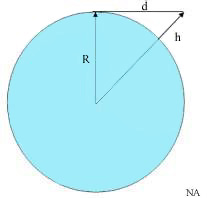Rohn Emergency Scale: Difference between revisions
en>Phil Boswell m convert dodgy URL to ID using AWB |
en>MarkRoxWiki No edit summary |
||
| Line 1: | Line 1: | ||
'''Earth bulge''' is a term used in [[telecommunication]]s. It refers to the circular segment of earth profile which blocks off long distance communications. | |||
== Distance to horizon == | |||
[[File:Earthbulge.jpg|frame|'''R''' is the radius of the Earth, '''h''' is the height of the transmitter (exaggerated), '''d''' is the line of sight distance]] | |||
Assuming a perfect sphere with no terrain irregularity, the distance to horizon from a high altitude [[Transmitter station|transmitter]] (i.e. line of sight) can readily be calculated. | |||
Let '''R''' be the radius of Earth and '''h''' be the altitude of a telecommunication station. Line of sight distance '''d''' of this station is given by the [[Pythagorean theorem]]; | |||
: <math>d^2=(R+h)^{2}-R^2= 2\cdot R \cdot h +h^2</math> | |||
Since the altitude of the station is much less than the radius of the Earth, | |||
: <math>d \approx \sqrt{ 2\cdot R \cdot h}</math> | |||
The mean radius of the earth is about {{convert|6378|km}}. (See [[Earth radius]]) Using the same units for both the altitude of the station and the radius of the earth, | |||
: <math>d \approx \sqrt{ 2\cdot 6378 \cdot h} \approx 112.9 \cdot \sqrt{ \cdot h} </math> | |||
If the height is given in '''m.''' and distance in '''km'''. | |||
: <math>d \approx 3.57 \cdot \sqrt{h}</math> | |||
If the height is given in '''ft.''' and the distance in '''miles''', | |||
: <math>d \approx 1.23 \cdot \sqrt{h}</math> | |||
== The actual service range == | |||
The above analysis doesn’t take the effect of atmosphere on the propagation path of the RF signals into consideration. In fact, the RF signals don’t propagate in straight lines. Because of the canalizing effects of atmospheric layers, the propagation paths are somewhat curved. Thus, the maximum service range of the station, is not equal to the [[line-of-sight propagation|line of sight]] distance. Usually a factor '''k''' is used in the equation above | |||
: <math>d \approx \sqrt{2 \cdot k \cdot R \cdot h} </math> | |||
'''k > 1''' means geometrically reduced bulge and a longer service range. On the other hand, '''k < 1''' means a shorter service range. | |||
Experience has shown that, under normal weather conditions '''k''' is '''4/3'''.<ref>R.Busi: ''Technical Monograph 3108-1967 High Altitude VHF and UHF Broadcasting Stations'', European Broadcasting Union Brussels,1967</ref> That means that, the maximum service range increases by '''% 15''' | |||
: <math>d \approx 4.12 \cdot \sqrt{h} </math> | |||
for '''h''' in '''m.''' and '''d''' in '''km.''' | |||
: <math>d \approx 1.41 \cdot\sqrt{h} </math> | |||
for '''h''' in '''ft.''' and '''d''' in '''miles''' ; | |||
But in stormy weather, '''k''' may decrease to cause fading in transmission. (In extreme cases '''k''' can be less than '''1'''.) That is equivalent to a hypothetical decrease in Earth radius and an increase of Earth bulge.<ref>This analysis is for high altitude to sea level reception. In microwave radio link chains, both stations are high altitudes.</ref> | |||
== Example == | |||
In normal weather conditions, the service range of a station at an altitude of '''1500 m.''' with respect to receivers at sea level can be found as, | |||
: <math>d \approx 4.12 \cdot \sqrt{1500} = 160 \mbox { km.}</math> | |||
== See also == | |||
*[[Radial (radio)]] | |||
*[[Transmitter]] | |||
*[[Field strength in free space]] | |||
*[[Line-of-sight propagation]] | |||
== References and notes == | |||
<references/> | |||
== External links == | |||
*http://wiki.answers.com/Q/What_is_the_formula_to_calculate_earth_bulge | |||
*http://www.wireless-center.net/Cisco-Wireless-Networking/728.html | |||
*http://web.telia.com/~u85920178/data/pathlos.htm#bulges | |||
*http://www.scribd.com/doc/52528816/64/The-Earth-bulge | |||
{{Analogue TV transmitter topics}} | |||
[[Category:Radio frequency propagation]] | |||
[[Category:Broadcast engineering]] | |||
Revision as of 07:27, 2 January 2014
Earth bulge is a term used in telecommunications. It refers to the circular segment of earth profile which blocks off long distance communications.
Distance to horizon

Assuming a perfect sphere with no terrain irregularity, the distance to horizon from a high altitude transmitter (i.e. line of sight) can readily be calculated.
Let R be the radius of Earth and h be the altitude of a telecommunication station. Line of sight distance d of this station is given by the Pythagorean theorem;
Since the altitude of the station is much less than the radius of the Earth,
The mean radius of the earth is about Template:Convert. (See Earth radius) Using the same units for both the altitude of the station and the radius of the earth,
If the height is given in m. and distance in km.
If the height is given in ft. and the distance in miles,
The actual service range
The above analysis doesn’t take the effect of atmosphere on the propagation path of the RF signals into consideration. In fact, the RF signals don’t propagate in straight lines. Because of the canalizing effects of atmospheric layers, the propagation paths are somewhat curved. Thus, the maximum service range of the station, is not equal to the line of sight distance. Usually a factor k is used in the equation above
k > 1 means geometrically reduced bulge and a longer service range. On the other hand, k < 1 means a shorter service range.
Experience has shown that, under normal weather conditions k is 4/3.[1] That means that, the maximum service range increases by % 15
for h in m. and d in km.
for h in ft. and d in miles ;
But in stormy weather, k may decrease to cause fading in transmission. (In extreme cases k can be less than 1.) That is equivalent to a hypothetical decrease in Earth radius and an increase of Earth bulge.[2]
Example
In normal weather conditions, the service range of a station at an altitude of 1500 m. with respect to receivers at sea level can be found as,